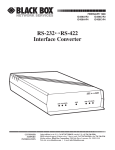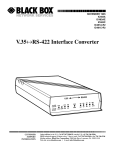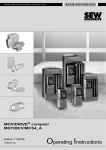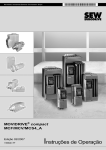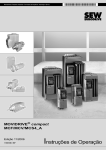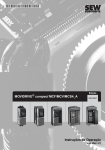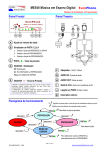Download Black Box ME540A-ST
Transcript
FEBRUARY 1998 ME540A-ST ME540A-SM FOM Line Driver—ST FOM Line Driver—SM CUSTOMER SUPPORT INFORMATION Order toll-free in the U.S.: Call 877-877-BBOX (outside U.S. call 724-746-5500) FREE technical support 24 hours a day, 7 days a week: Call 724-746-5500 or fax 724-746-0746 Mailing address: Black Box Corporation, 1000 Park Drive, Lawrence, PA 15055-1018 Web site: www.blackbox.com • E-mail: [email protected] FEDERAL COMMUNICATIONS COMMISSION AND CANADIAN DEPARTMENT OF COMMUNICATIONS RADIO FREQUENCY INTERFERENCE STATEMENTS This equipment generates, uses, and can radiate radio frequency energy and if not installed and used properly, that is, in strict accordance with the manufacturer’s instructions, may cause interference to radio communication. It has been tested and found to comply with the limits for a Class A computing device in accordance with the specifications in Subpart J of Part 15 of FCC rules, which are designed to provide reasonable protection against such interference when the equipment is operated in a commercial environment. Operation of this equipment in a residential area is likely to cause interference, in which case the user at his own expense will be required to take whatever measures may be necessary to correct the interference. Changes or modifications not expressly approved by the party responsible for compliance could void the user’s authority to operate the equipment. This digital apparatus does not exceed the Class A limits for radio noise emission from digital apparatus set out in the Radio Interference Regulation of the Canadian Department of Communications. Le présent appareil numérique n’émet pas de bruits radioélectriques dépassant les limites applicables aux appareils numériques de classe A prescrites dans le Règlement sur le brouillage radioélectrique publié par le ministère des Communications du Canada. INSTRUCCIONES DE SEGURIDAD (Normas Oficiales Mexicanas Electrical Safety Statement) 1. Todas las instrucciones de seguridad y operación deberán ser leídas antes de que el aparato eléctrico sea operado. 2. Las instrucciones de seguridad y operación deberán ser guardadas para referencia futura. 3. Todas las advertencias en el aparato eléctrico y en sus instrucciones de operación deben ser respetadas. 4. Todas las instrucciones de operación y uso deben ser seguidas. 5. El aparato eléctrico no deberá ser usado cerca del agua—por ejemplo, cerca de la tina de baño, lavabo, sótano mojado o cerca de una alberca, etc. 6. El aparato eléctrico debe ser usado únicamente con carritos o pedestales que sean recomendados por el fabricante. 7. El aparato eléctrico debe ser montado a la pared o al techo sólo como sea recomendado por el fabricante. 8. Servicio—El usuario no debe intentar dar servicio al equipo eléctrico más allá a lo descrito en las instrucciones de operación. Todo otro servicio deberá ser referido a personal de servicio calificado. 9. El aparato eléctrico debe ser situado de tal manera que su posición no interfiera su uso. La colocación del aparato eléctrico sobre una cama, sofá, alfombra o superficie similar puede bloquea la ventilación, no se debe colocar en libreros o gabinetes que impidan el flujo de aire por los orificios de ventilación. 10. El equipo eléctrico deber ser situado fuera del alcance de fuentes de calor como radiadores, registros de calor, estufas u otros aparatos (incluyendo amplificadores) que producen calor. 11. El aparato eléctrico deberá ser connectado a una fuente de poder sólo del tipo descrito en el instructivo de operación, o como se indique en el aparato. 12. Precaución debe ser tomada de tal manera que la tierra fisica y la polarización del equipo no sea eliminada. 13. Los cables de la fuente de poder deben ser guiados de tal manera que no sean pisados ni pellizcados por objetos colocados sobre o contra ellos, poniendo particular atención a los contactos y receptáculos donde salen del aparato. 14. El equipo eléctrico debe ser limpiado únicamente de acuerdo a las recomendaciones del fabricante. 15. En caso de existir, una antena externa deberá ser localizada lejos de las lineas de energia. 16. El cable de corriente deberá ser desconectado del cuando el equipo no sea usado por un largo periodo de tiempo. 17. Cuidado debe ser tomado de tal manera que objectos liquidos no sean derramados sobre la cubierta u orificios de ventilación. 18. Servicio por personal calificado deberá ser provisto cuando: A: El cable de poder o el contacto ha sido dañado; u B: Objectos han caído o líquido ha sido derramado dentro del aparato; o C: El aparato ha sido expuesto a la lluvia; o D: El aparato parece no operar normalmente o muestra un cambio en su desempeño; o E: El aparato ha sido tirado o su cubierta ha sido dañada. FOM LINE DRIVER—ST AND S M Contents Chapter Page 1. Specifications ..........................................................................................................................................4 2. Introduction ..........................................................................................................................................5 2.1 Ports ............................................................................................................................................5 2.2 Speed and Distance ....................................................................................................................5 3. Configurations........................................................................................................................................6 3.1 Network Mode ............................................................................................................................6 3.2 Master/Slave Mode ......................................................................................................................7 3.3 Point-to-Point ..............................................................................................................................8 4. Installation..............................................................................................................................................9 4.1 Setup............................................................................................................................................9 4.2 RS-232 ......................................................................................................................................10 4.3 RS-485 ......................................................................................................................................10 4.4 20-mA Current Loop (Point to Point) ......................................................................................13 5. Quick Setup Guide ..............................................................................................................................14 6. Troubleshooting....................................................................................................................................17 6.1 Application Problems ................................................................................................................17 6.2 Calling Your Supplier ..............................................................................................................17 6.3 Shipping and Packaging ..........................................................................................................17 TRADEMARKS USED IN THIS MANUAL ST is a registered trademark of American Telephone and Telegraph Company. All applied-for and registered trademarks are the property of their respective owners. 3 FOM LINE DRIVER—ST AND S M 1. Specifications Protocol — Speed — Maximum Distance — Operation — No. of Drops Supported — Interface — Connectors — Indicators — User Controls — Link Budget — Fiber Launch Power — Receiver Sensitivity — Wavelength — Cable Requirements — MTBF — Relative Humidity Tolerance — Operating Temperature — Storage Temperature — Power — Size — Weight — 4 Asynchronous Transparent through 20 Kbps on 20-mA current loop port, 64 Kbps on RS-232 port, 128 Kbps on RS-485 port 5000 feet (1524 m) on 62.5 micron Network or master/slave mode, multipoint half-duplex (NOTE: A software protocol is required); Point-to-point line driver operation, full duplex 64 RS-232 DCE/DTE, RS-485, 20-mA current loop—active or passive transmit and receive, fiberoptic transmit and receive (1) DB9, (4) ST® or SMA, (1) 4-screw terminal block (10) LEDs: 232, 485, 20mA, NETWORK, MASTER, SLAVE, PORT B TXD, PORT B RXD, PORT A TXD, PORT A RXD (1) Pushbutton: Pressed in enables DLB (Digital Loopback) mode, and fully extended enables NORMAL mode 50-125µ cable: 2.5 dB; 62.5-125µ cable: 6 dB; 100-140µ cable: 11.5 dB -14 dB -25 dB 820 nm Use multi-mode fiber cable; use up to 200 micron fiberoptic cable; 62.5 micron fiber is recommended 168,000 hours 10 to 95%, noncondensing 32 to 114°F (0 to 45°C) -40 to +176°F (-40 to +80°C) 115 VAC, 60/50 Hz, external (part number PS154) 1.8"H x 5.5"W x 8.5"D (4.6 x 14 x 21.6 cm) 2 lb. (0.9 kg) FOM LINE DRIVER—ST AND S M 2. Introduction With the FOM Line Driver, you can use an RS-232, RS-485, or 20-mA digital current-loop device in a multi-drop half-duplex or point-to-point full-duplex environment using fiber optics as the transmission media. The Driver is user-configurable in any of these operating modes: network mode, master/slave mode, or full-duplex point-to-point configuration. 2.1 Ports The FOM Line Driver has a single RS-232 DB9 female connector. TX and RX are parallel with a 20-mA current-loop and RS-485 interface sharing a common terminal block with a switch to select the desired interface. This will let you connect an RS-232, RS-485, or current-loop device to a fiberoptic link. There are also two sets of fiberoptic receivers and transmitters with ST or SMA connectors supporting standard fiber cable through 200 microns (multimode). 2.2 Speed and Distance The Line Driver runs at up to 20 Kbps on the 20-mA current-loop port, up to 64 Kbps on the RS-232 port, and up to 128 Kbps on the RS-485 port. Maximum distance is 5000 feet (1524 m). Figure 2-1 illustrates the Line Driver’s features. WALLMOUNT POWER SUPPLY CONNECTORS CONNECTORS TX RX TX RX DB-9 TERMINAL BLOCK Figure 2-1. The FOM Line Driver. 5 FOM LINE DRIVER—ST AND S M 3. Configurations There are three operating modes you can choose from: network mode, master/slave mode, or point-topoint configuration. In network mode, all of the units are configured. If you want one Line Driver configured as a master and the others as slaves, you need to be in master/slave mode. Finally, point-topoint configuration is a full-duplex mode where both FOM Line Drivers are configured as masters. This chapter describes each scenario in greater detail. Read the entire chapter before deciding which configuration is right for you. 3.1 Network Mode In this mode, data sent to the transmitter (TX) of the RS-232 DB9, 20-mA current loop, or RS-485 terminal block is passed out to both optical transmitters (TX). Data received from either optical receiver (RX) is passed through to the opposite optical port’s transmitter (TX), to the receiver (RX) of the RS-232 DB9, the 20-mA current loop, or the RS-485 port. NOTE There is no collision detection. Data Path TX RX TX RX 232/485/C. Loop Receiving Receiving Fiber Cabling TX RX TX RX TX RX TX RX 232/485/C. Loop Transmitting Receiving TX RX TX RX TX RX TX RX 232/485/C. Loop Receiving Transmitting TX RX TX RX TX RX 232/485/C. Loop Receiving Receiving TX RX Figure 3-1. All units configured in network mode. As you look at the example above, keep these things in mind. • In network mode, all of the devices look the same. There are no masters or slaves. • Data flow is half-duplex only. • All devices see all data on the network. 6 TX RX TX RX FOM LINE DRIVER—ST AND S M 3.2 Master/Slave Mode When the master sends data to the transmitter (TX) of the RS-232 DB9, the 20-mA current loop, or the RS-485 terminal block, the data is passed through to the master’s B optical port. From there, it is daisychained to each slave’s B optical RX. As each slave receives the data, it is passed through to the DB9 RX and the receive (RX) terminal block. When the data reaches the slave that needs to respond, it will send data to the optical A TX port and out to the next daisychained slave in the direction of the master. The information is retransmitted and travels from daisychained slave to slave in the direction of the master until it reaches the master’s Port A. Figure 3-2 illustrates this configuration. Although the information is traveling through the other slaves, slaves don’t “see” data from other slaves. This keeps the slaves from having to stop working in order to translate another slave’s information. Data Path TX RX B TX RX A Master Transmitting Receiving Fiber Cabling TX RX B TX RX A Master TX RX B TX RX A Slave Receiving Receiving TX RX B TX RX A Slave TX RX B TX RX A Slave Receiving Transmitting TX RX B TX RX A Slave TX RX B TX RX A Slave Receiving Receiving TX RX B TX RX A Slave Figure 3-2. One unit configured as a master, all others as slaves. As you look at the example above, keep these things in mind. • Data flow is half-duplex only. • The master transmits out of Port B only. • Slaves transmit out of Port A only, and that transmission goes to the master. • When a slave receives data in Port A, the data is looped back out Port A. • When a slave receives data in Port B, the data is looped back out Port B and is sent out the DB9 port (from the master). • The master receives in Port A only. 7 FOM LINE DRIVER—ST AND S M 3.3 Point-to-Point Set up as shown in Figure 3-3, the Line Driver can run in full-duplex mode across the fiber connecting an RS-232, RS-485, or 20-mA current-loop device to another RS-232, RS-485, or 20-mA current-loop device. TX RX TERMINAL BLOCK RX DB-9 TX RX FIBER OPTIC CABLE TX DB-9 TX RX TX RX RX TX TERMINAL BLOCK Figure 3-3. Point-to-point—Both units configured as masters. NOTE The same interface is not required on both sides. 8 FOM LINE DRIVER—ST AND S M 4. Installation 4.1 Setup Factory-default settings are marked with asterisks. Determine which interface should be active, and set XW2 accordingly. RS-232 ......................................XW2A* RS-485 ......................................XW2B 20-mA Current Loop ................XW2C Determine the mode in which you want the Line Driver to operate. If you want all of the Line Drivers to be configured, choose 0 (on S1, position 1) for Network Mode. If you want the Master/Slave Mode (for either a half-duplex mode where one Line Driver is the master and the others are slaves or for point to point, the full-duplex mode where both Line Drivers are configured as masters), choose 1. S1, Position 1—Mode Select 0 ------Network Mode 1 ------Master/Slave Mode If you choose to operate in Master/Slave Mode, you need to designate whether this Line Driver will be a master or a slave. On S1, set position 2 to 0 if you want the Driver to be a master and 1 if you want it to be a slave. If you chose Network mode above, you do not need to set S1, position 2. S1, Position 2—Master/Slave Select 0 ------Master* 1 ------Slave NOTE To use the following switch positions appropriately, you should have a firm understanding of your network requirements. S1, Position 5 and 6 are used as a pair to bias the Line Driver’s receivers and must be moved together. S1, Position 3 and 4 are used as a pair to bias the Line Driver’s TX pair and must be moved together. In most RS-485 applications, you would bias your RX (S1, Position 5 and 6) ON or closed. For example, say you have an RS-485 network in an idle condition with all nodes in the receive mode. Since the drivers are tri-stated, the line voltage could be either positive or negative—there’s no way to know for sure. If the voltage level at the TB1-2 and TB1-1 inputs is less than 200mV, the logic level at the output of the RX will be the last bit received. To force the line into an idle condition, you’d need to set the switch S1, Position 5 and 6, which will add resistors. Refer to Figure 4-1. S1, Positions 3 through 6—RS-485 Failsafe/Biased Line 0 ------No Bias 1 ------Biased If you selected RS-485 as your interface, you’ll need to set S1, positions 7 and 8, for termination. The physical ends (the first and last Drivers) must be terminated and the ones in between are unterminated. Positions 7 and 8 must be set in pairs (both terminated or both unterminated). Note that a star topology will not work with these Line Drivers. S1, Positions 7 and 8—RS-485 Termination 0 ------Unterminated 1 ------Terminated *Factory default. KEY 0 = Open/Off 1 = Closed/On 9 FOM LINE DRIVER—ST AND S M Fiberoptic Cable Connections Because of the subtleties of the various modes of operation, review Chapter 3, Configurations, for the proper inter-unit connections. If you chose XW2A (RS-232) as your interface selection, go to Section 4.2. If you chose XW2B (RS-485) as your interface selection, go to Section 4.3. If you chose XW2C (20-mA current loop) as your interface selection, go to Section 4.4. 4.2 RS-232 Follow these instructions to set up the RS-232 interface. 1. Set XW1. XW1A sets the Driver for DCE. XW1B sets the Driver for DTE. XW1A ------DCE* XW1B ------DTE DB9 Pinouts DCE 2—TX Data 3—RX Data 7—RTS Input 4—DTR Input 8—CTS Output 6—DSR Held High 1—CD Held High 5—Signal Ground 2. DTE 2—RX Data 3—TX Data 7—RTS Held High 4—DTR Held High 5—Signal Ground 8—No Connect 6—No Connect 1—No Connect Set W3. If you selected XW1A (DCE), Position AB will enable DTR (DTR controls CTS). In position BC, RTS controls CTS. If you selected XW1B (DTE), all handshake leads are ignored, and W3 will have no effect. It’s not necessary to set W3. If XW1A was selected, Position AB ------DTR* or If XW1A was selected, Position BC ------RTS loops back to raise CTS or If XW1B was selected, W3 has no effect. 3. Set W2. W2 sets the delay of CTS assertion with the raising of DTR or RTS. 0 means there will be no delay. 10 gives you a 10-millisecond delay, and 30 is a 30-millisecond delay. 0------------No delay 10----------10-msec. delay 30----------30-msec. delay 10 *Factory default. FOM LINE DRIVER—ST AND S M 4.3 RS-485 Follow these instructions to set up the RS-485 interface. 1. Connect the wire to the terminal block. Set the wire to TB1 (the 4-wire terminal block) as indicated below for 4-wire RS-485 applications: Position 1 ------Receive B positive Position 2 ------Receive A negative Position 3 ------Transmit B positive Position 4 ------Transmit A negative For 2-wire RS-485 applications, tie Transmit A negative to Receive A negative and Transmit B positive to Receive A positive. See the illustration below. RXB (+) RXA (-) TXB (+) TXA (-) 2. 3. Set S5. Move S5 to the RS-485 position, B*. S5 determines which circuit is tied to TB1. Set W4, W5, and W6. For 4-wire operation: W4 and W5 are in the A-B position (as shipped). When configured for 4-wire, W6 is not used. For 2-wire operation: Move W4 and W5 to the B-C position. W6 is now used to set the time the driver will remain enabled after the transmission of the last data bit (see below). A ----------7-msec. delay B ----------2-msec. delay C ----------0.7-msec. delay D ----------0.15-msec. delay 4. Set S1. If the RS-485 receiver needs to be terminated, move S1 positions 7 and 8 both ON. Note that both switches must either be ON or OFF simultaneously. To terminate: Position 7 ------1 (terminated) Position 8 ------1 (terminated) Not terminated: Position 7 ------0 (unterminated) Position 8 ------0 (unterminated) *Factory default. KEY 0 = Open/Off 1 = Closed/On 11 FOM LINE DRIVER—ST AND S M 5. Biased, Failsafe Operation (S1, positions 3 through 6). S1 positions 3 through 6, when in the 1 or ON position, switch in a 1K pull-up resistor to the A input/output and a 1K pull-down to the B input/output (see Figure 4-1). 0 is the OFF position. In almost all 2- or 4-wire RS-485 applications, positions 3 and 4 should be OFF and positions 5 and 6 should be ON. Note that positions 3 and 4 and positions 5 and 6 should always be moved in pairs, either both open or both closed. NOTE To use S1 positions 3 through 6 appropriately, you should have a firm understanding of your network requirements. Line Driver S1 Position 3 1K TB1-4 Data Flow TX TB1-3 1K S1 Position 4 +5V S1 Position 6 1K TB1-2 RX Data Flow TB1-1 1K S1 Position 5 Figure 4-1. Biased/Failsafe Operation Switches (RS-485). 12 +5V FOM LINE DRIVER—ST AND S M 4.4 20-mA Current Loop (Point to Point) NOTE To use the following switch positions appropriately, you should have a firm understanding of your network requirements. 1. Connect the wire to the terminal block. Set the wire to TB1 (the 4-wire terminal block) as indicated below for 4-wire current-loop applications: Position 1 ------Receive B positive (+) Position 2 ------Receive A negative (-) Position 3 ------Transmit B positive (+) Position 4 ------Transmit A negative (-) 2. Set S5. Move S5 to the Current Loop position, A. S5 determines which circuit is tied to TB1. 3. Set S2 and S3. To configure the current loop transmitter and/or receiver as active or passive, set S2 and S3 as shown below. S2—20-mA Current-Loop Receive A --------Active B --------Passive S3—20-mA Current-Loop Transmit A --------Active B --------Passive 13 FOM LINE DRIVER—ST AND S M 5. Quick Setup Guide XW1B = Sets the RS-232 interface for DTE XW1A = Sets the RS-232 interface for DCE W2 = RTS/CTS delay XW2A = RS-232 interface + + + + + + RX A - 0 10 30 ms + + + RX A + TX A TX A W2 A 1 X W 1 B RS-232 interface (DB9 connector) X W 1 A + B - A + B - A Loopback Switch Rx Tx B C 2 RX B TX B 3 4 Slave Master W3 Network RX B S1 20mA RS-485 TX B RS-232 W3 When the unit is set to DCE (XW1A) Pos. AB selects CTS response to DTR Pos. BC selects CTS response to RTS When the unit is set to DTE (XW1B), this strap has no function S1 Pos. 1 = Mode Select 0 = Network Mode 1 = Master/Slave Mode Pos. 2 = Master/Slave Select 0 = Master 1 = Slave KEY 0 = Open/Off 1 = Closed/On Figure 5-1. Circuit board with RS-232 options. 14 FOM LINE DRIVER—ST AND S M W6 When in 2-wire, this is the time that the driver remains enabled after the TX of the last data bit. Delays are: A = 7 ms B = 2 ms C = 0.7 ms D = 0.15 ms XW2B = RS-485 interface RS-485 Terminal Block S5 set to B (RS-485) - + + + + + + RX A + Loopback Switch + + W6 RX A + TX A A A 1 + B - A + B - A W5 Rx Tx TX A S5 B RX B C 2 TX B 3 4 Slave W4 B Master Network RX B S1 20mA RS-485 TX B RS-232 S1 Pos. 1 = Mode Select 0 = Network Mode 1 = Master/Slave Mode W4 and W5 Set for the AB position = 4 wire Set for the BC position = 2 wire Pos. 2 = Master/Slave Select 0 = Master 1 = Slave Pos. 3 & 4 = Bias TX (see pg. 9) 0 = No Bias 1 = Biased KEY 0 = Open/Off 1 = Closed/On Pos. 5 & 6 = Bias RX (see pg. 9) 0 = No Bias 1 = Biased Pos. 7 & 8 = RS-485 Termination 0 = Unterminated 1 = Terminated Figure 5-2. Circuit board with RS-485 options. 15 FOM LINE DRIVER—ST AND S M S5 set to A (20mA) XW2C = 20-mA interface + + + Loopback Switch + + + + RX A - 20-mA Terminal Block + + RX A + TX A TX A A A 1 + B - A RS-232 + B - A Rx Tx B RX B C 2 TX B 3 4 Slave B Master Network RX B S1 S2 S3 A A RS-485 TX B B B S1 Pos. 1 = Mode Select 0 = Network Mode 1 = Master/Slave Mode Pos. 2 = Master/Slave Select 0 = Master 1 = Slave S2 and S3 S2 Pos. A = Active RX S2 Pos. B = Passive RX S3 Pos. A = Active TX S3 Pos. B = Passive TX KEY 0 = Open/Off 1 = Closed/On Figure 5-3. Circuit board with 20-mA current-loop options. 16 20mA RS-232 FOM LINE DRIVER—ST AND S M 6. Troubleshooting 6.1 Application Problems If you’re having a problem with your application, reread the manual. Make sure you’ve selected the appropriate switches for the interface you chose. If your Line Driver is still not working properly, fill out an application diagram (found on pages 19, 21, and 23). Do this before you call for technical support. Having this information handy will help the Technical Support staff determine whether your Line Driver has been configured correctly for your application. 6.2 Calling Your Supplier If you determine that your FOM Line Driver is malfunctioning, do not attempt to alter or repair the unit. It contains no user-serviceable parts. Contact your supplier. Before you do, make a record of the history of the problem. Your supplier will be able to provide more efficient and accurate assistance if you have a complete description, including: • the nature and duration of the problem. • when the problem occurs. • the components involved in the problem. • any particular application that, when used, appears to create the problem or make it worse. 6.3 Shipping and Packaging If you need to transport or ship your Line Driver: • Package it carefully. We recommend that you use the original container. • If you are shipping the FOM Line Driver for repair, make sure you include everything that was included in the original package. Before you ship, contact your supplier to get a Return Materials Authorization (RMA) number. 17 FOM LINE DRIVER—ST AND S M Application Diagram forms are found on pages 19, 21, and 23. You may be asked to fax your diagram to the Technical Support department. Use scissors to remove the page. 18 FOM LINE DRIVER—ST AND S M TX RX TX B A B Local Node XW2 XW1 XW1 W3 W3 W2 W2 S5 S5 W4 W4 W5 W5 W6 W6 S2 S2 S3 S3 S1: S1: 2 3 4 5 RX A Remote Node XW2 1 RX TX TX RX 6 7 8 1 2 3 4 5 6 NOTE NOTE 0 = Open or Off 1 = Closed or On 0 = Open or Off 1 = Closed or On 7 8 19 FOM LINE DRIVER—ST AND S M 20 TX RX TX B RX A B Local Node XW2 XW1 XW1 W3 W3 W2 W2 S5 S5 W4 W4 W5 W5 W6 W6 S2 S2 S3 S3 S1: S1: 2 3 4 5 RX A Remote Node XW2 1 RX TX TX 6 7 8 1 2 3 4 5 6 NOTE NOTE 0 = Open or Off 1 = Closed or On 0 = Open or Off 1 = Closed or On 7 8 21 FOM LINE DRIVER—ST AND S M 22 TX RX TX B RX A B Local Node XW2 XW1 XW1 W3 W3 W2 W2 S5 S5 W4 W4 W5 W5 W6 W6 S2 S2 S3 S3 S1: S1: 2 3 4 5 RX A Remote Node XW2 1 RX TX TX 6 7 8 1 2 3 4 5 6 NOTE NOTE 0 = Open or Off 1 = Closed or On 0 = Open or Off 1 = Closed or On 7 8 23 FOM LINE DRIVER—ST AND S M 24 FOM LINE DRIVER—ST AND S M 25 © Copyright 1998. Black Box Corporation. All rights reserved. 1000 Park Drive • Lawrence, PA 15055-1018 • 724-746-5500 • Fax 724-746-0746


























